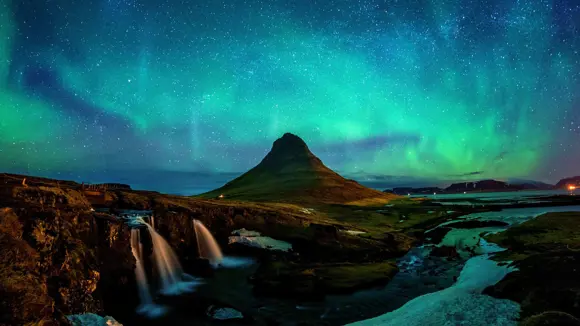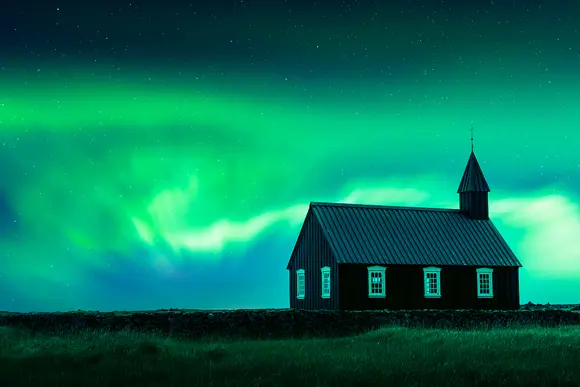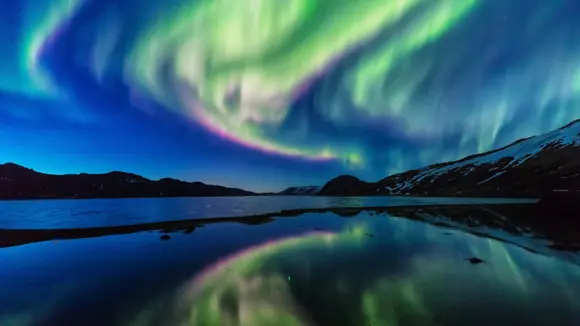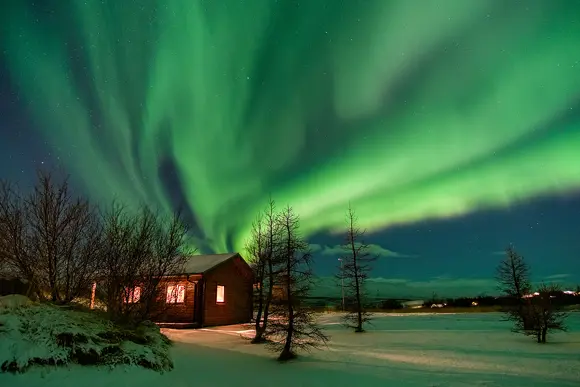Northern Lights Iceland: When and Where to See Them

Shining in bright hues across the Arctic sky, the Northern Lights have mesmerised people across the world. It’s no wonder that a lot of visitors to Iceland want them to be the highlight of their trip. If you’re one of them, keep reading to discover the best times and places to see the Northern Lights in Iceland.
When to See the Northern Lights in Iceland
Winter is the best time to see the Northern Lights in Iceland, with most tours being offered from September/October to March/April. The long nights with up to 20 hours of darkness provide an ideal hunting ground for capturing the aurora borealis. The phenomenon, however, is highly dependent upon weather conditions, especially cloud cover, since you need clear skies to view them.
Best Months to See Iceland’s Northern Lights
December is the best month for spotting the Northern Lights as the nights are the longest and darkest. Plus, you also get to celebrate Christmas and the New Year in Icelandic style! But if you can’t make it during the holiday season, November and January also provide a good opportunity to spot the lights, as Iceland’s peak winter months. To be fair, summer months are the only time you’ll have the least chance of viewing them due to increased daylight.
Best Time of Day to Spot the Northern Lights
The middle of the night, from 11 pm to 2 am, is the best time for spotting the Northern Lights in Iceland. The night sky is at its darkest during these hours, which maximises your chances of seeing this colourful phenomenon. But staying up late doesn’t have to be your only option. In the winter, aurora borealis can start as early as 4 pm!

Where to See the Northern Lights in Iceland
If seeing the Northern Lights is set to be the highlight of your Iceland trip, you need to think about where you’ll be staying. Remote regions with minimal light pollution are excellent spots; Kirkjufell, Thingvellir National Park, and Asbyrgi Canyon are only some of the attractions that serve as ideal hunting grounds for the Northern Lights.
You don’t necessarily have to stay next door to these attractions either. The fishing village of Vík, for instance, is only a few hours’ drive from Reykjavík. If you’re willing to make the trek, the Westfjords are a bit further afield but offer more hours of darkness, maximising your chances of viewing them.
Can You See the Northern Lights in Reykjavík?
Absolutely! As light pollution is higher in Reykjavík than in other parts of Iceland, the Northern Lights can seem less vivid, but you can still see them. In fact, there are numerous hidden spots in the city and its surrounding areas where you may not have thought of hunting for the Northern Lights. Heidmörk Park, Reynisvatn & Hafravatn Lakes, and Mount Ulfarsfell are some of these lesser-known spots. Videy Island and the hill of Öskjuhlíð are some more convenient locations in the region.

Viewing Conditions for the Northern Lights
The Northern Lights are undoubtedly among the most mysterious phenomena on Earth. Caused by the earth’s atmosphere interacting with charged particles from the sun, the process is highly volatile, but also extremely beautiful. Clear skies and dark nights are the main conditions you need for viewing them, both of which are most common in Iceland during winter months.
You also need the right solar conditions and strong solar activity for the phenomenon to be clear to see. The sun has different phases, and maximum solar activity occurs every 11 years. According to scientists, the next period of peak solar activity is going to fall between 2023 and 2025. Make sure watch out for the aurora borealis across the Nordic skies!
How to See the Northern Lights
The most important thing you need for spotting the Northern Lights is patience. Once the conditions are right, the phenomenon can happen at any time, although it’s usually strongest around midnight.
At the start of the aurora activity, you’ll see a green arc towards the north. Look for the Polar Star as it always shines in the north. If you can’t find it, look for the Big Bear or Ursa Major constellation as it's close by. Once you see the green arc, head towards it.

Knowing when and where you’ll have the best chances of viewing the Northern Lights in Iceland is crucial if you want it to be the highlight of your trip. Although the phenomenon is reliant upon the right conditions, certain times of the year and places can maximise your chances of viewing them. Now that you’re equipped with this information, start planning your trip by booking a stay at one of Iceland’s top hotels.